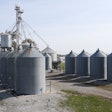
The Maillard reaction is an integral and unavoidable part of feed manufacturing. Its adverse effects are experienced via reduced nutrient availability (Table 1) due to excess thermal processing and prolonged storage in both finished diets and ingredients.
The Maillard reaction involves binding of amino groups to the carbonyl group of reducing sugars, such as those found in glucose and lactose. Although sugar losses are greater and more intense than amino acid losses, it is the deterioration of protein quality that is of most concern.
Browning is often confused with the intensity of the Maillard reaction. However, coloration and amino acid losses are two independent phenomena of the Maillard reaction process. During the initial stages of the Maillard reaction, even though products remain colorless, amino acids have already started becoming unavailable to the animal. The Maillard reaction may take place at room temperature, but its intensity increases as time, temperature, moisture (maximum at 40 to 70 percent), and alkalinity (linear between pH 3 and 8) increase.
The initial Maillard reaction products have autocatalytic properties that further intensify the effects of heat treatment and storage.
Effects on lysine
Destruction of lysine is accomplished in two ways. First, lysine is bound to sugars, forming early-Maillard reaction products. Although at this stage lysine is still detectable in chemical assays, it is no longer bioavailable. Second, the formation of late-Maillard reaction products, such as melanoides, reduces the amount of chemically analyzed lysine. This is the stage where coloration intensifies.
The adverse effects of the Maillard reaction on lysine bioavailability have been extensively demonstrated in feed ingredients, such as field peas, soybean meal, fish protein isolate, casein, egg albumin, canola meal, peanut meal and sunflower meal. It has been repeatedly demonstrated that thermal over-processing of high-protein materials reduces lysine bioavailability, depending on temperature levels and the duration of heat application.
In some instances, such as in cottonseed meal, digestibility may be unaffected by heat treatment, although lysine bioavailability is severely reduced. It appears that there is an inverse relationship between temperature and time such that, as temperature declines, more time is needed for the same loss of lysine bioavailability and vice versa.
Destruction during feed manufacturing
Piglet diets are often rich in milk products, which contain relatively high amounts of lactose and lysine. Moreover, most complex diets for young animals, including ruminants, may contain a plethora of other equally sensitive ingredients such as blood products, concentrated soybean proteins, fish meal and wheat gluten that readily contribute to the Maillard reaction problem.
During pelleting, feed is exposed to relative high humidity and temperature levels. Usually 2 to 6 percent moisture is added to the mash during conditioning at temperatures that can range from 50 to 90 degrees Celsius from several seconds to 20 or more minutes. Extremely high temperatures can also develop during pellet formation due to friction with the die walls as the conditioned mash is forced through die openings.
More aggressive feed processing methods, such as expansion, extrusion, double pelleting and prolonged mash conditioning, also increase the risk of greater nutrient destruction via the Maillard reaction.
Storage considerations
Storage of heat-sensitive material in the form of finished diets or raw materials for prolonged periods of time can also initiate a second cycle of Maillard reactions. This is of paramount importance in feed management because the conditions of high temperature and relative humidity usually observed in most facilities for young animals are extremely favorable for the Maillard reaction.
Residual feed moisture greatly affects the extent of the Maillard reaction during storage. A 10 percent moisture level in milk powder stored for 10 weeks at 30 C resulted in a 20 percent loss in lysine bioavailability. Also, exposure of a pig starter diet for one week in a hot nursery environment reduced lysine bioavailability by about 12 percent (Table 2).
Exposure of feed to adverse environmental conditions can occur not only in animal rooms, but also during storage in silos and general storage areas during the summer months.
On the positive side, Maillard reaction products are responsible for the desirable cooked flavor of animal feeds and foods. This may be a contributing factor associated with increased feed intakes usually observed with pelleted diets. There is a paucity of meaningful information on this aspect and, thus, further research is required to take advantage of a natural, but unavoidable process in feed manufacturing.
In conclusion, minimal thermal processing and rapid inventory turnaround are important issues in combating the adverse effects of the Maillard reaction. Ingredient selection and combination is also important in reducing the exposure of heat-sensitive materials to further nutrient losses.

















